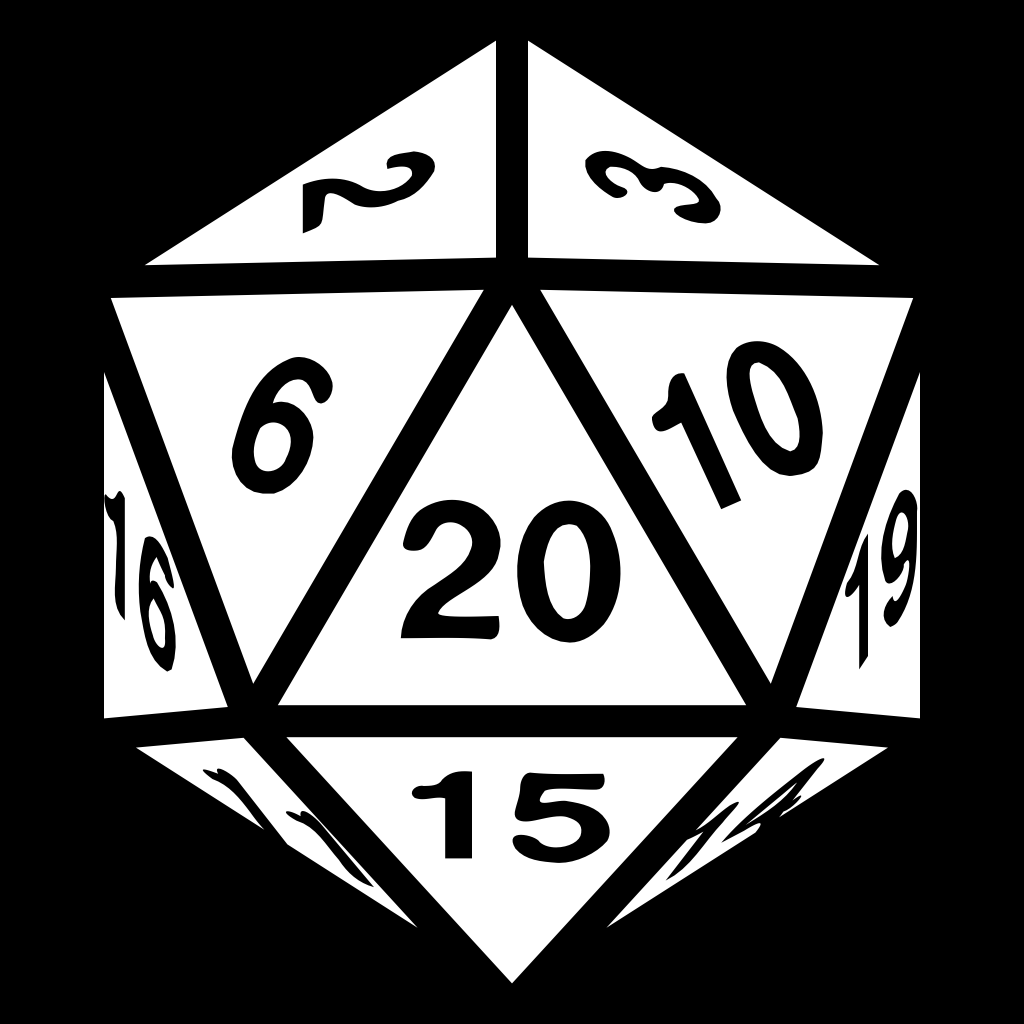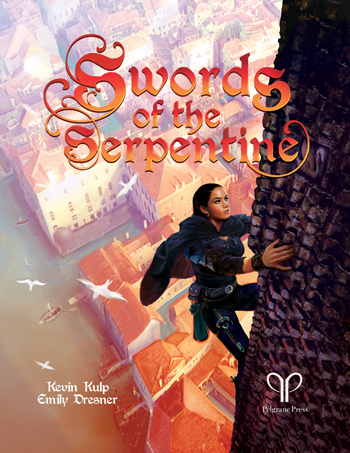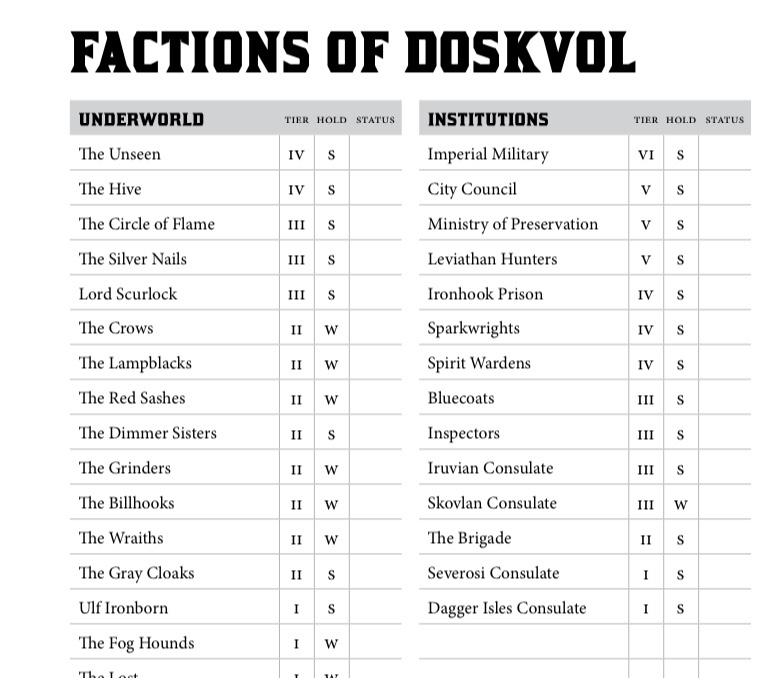I’ve been eagerly awaiting the release of the Swords of the Serpentine (SotS) RPG for some time, and as part of the pre-order, they offered a pre-layout version. Normally, I ignore those and just wait — layout is such an important part of RPGs that I prefer the whole package — but I had some reasonto look ahead, so I busted it out and gave it a read.
Going into SotS, it had a few elements going in its favor and a few strikes against it. Against it was the Gumshoe system, which I’d never quite synced with. I genuinely love how it handles investigation and clues, but for more mundane actions it uses a pool system combined with hidden difficulties, which is a combination I don’t enjoy. However, Gumshoe has also gone through numerous iterations since the last time I looked at it, so I had hope.
In the strong positive column was the talent behind this — Kevin Kulp and Emily Dresner. Kevin — in addition to being a great GM and a great guy — was the person behind Timewatch, another Gumshoe game which I’ve played (but not read) and which is an absolute delight. Emily is the author of such gems as Cute and Fuzzy Cockfighting Seizure Monsters but more critically she is the author of the Dungeonomicscolumns at Critical Hits. In these, she combines her sense of humor with her love of business to deconstruct Dungeons & Dragons ideas in fun and useful ways.
Lastly, the core pitch for SotS is Sword & Sandal urban adventure, which is a mixed bag for me. I’ve never been much of a Conan guy, but I love Lankhmar to my very bones, so a lot was going to depend on the specifics.
So, how’d it work out? Pretty well.
Foundation
How a game book opens is important to conveying the heart of the game. You don’t want to overwhelm with details, but you want to convey what’s unique and interesting about the game and give a reason to keep reading. SotS does a solid job of this with a quick sketch of the setting and a few interesting high points.
The setting is the city of Eversink, a center of commerce and culture at the mouth of a great river in a world that has ancient horrors, active gods and all that jazz. The signature weird thing about the city is that the buildings sink over time. Slowly, mostly, and at varying rates, but enough so that the city is built atop itself many times over.
This is neat, and it allows for things like deep dungeons and weirdly conflicting architectural styles with a high degree of verticality while still conveying a sense of decay, all wrapped in canals and waterways. But the thing which really grabbed me was a small bullet point about a beggar selling rocks. See, the goddess of the city is one of commerce, and this has lots of implications which get explored later, but one impact in particular is that you can’t just give someone money, so beggars sell “lucky stones”.
That probably seems like a weird thing to focus on when there are other bullets about dark sorceries, mighty thewed warriors and so on. But as a reader of settings, it’s gold to me for a couple of reasons:
- It conveys the presence of the goddess in a non-blatant way. Because this is a thing which is done, it conveys its taken seriously, which in turn suggests that the goddess’s opinion/dictates carry real weight even when there’s not necessarily an enforcement mechanism. It is rare to see religion conveyed as important in a setting with anything approaching a light touch.
- This is a very human hack. There are still beggars and still people with money, and the pattern of interaction exists, but it adapts to this reality. It looks dumb, but it has a logic to it, which feels more real.
In addition to a quick snapshot of the setting, we get a quick summary of the system and one bit of guidance out the gate: when a player asks a question about the setting, the go-to GM answer is going to be “You tell me”. That this is one of the first things emphasized sets a good tone for the rest of the book, both because it’s a great technique, and because it’s an opinionated technique.
Guts
Mechanically, this is a Gumshoe game. That tells you some details, but individual expressions of the Gumshoe system are – to my understanding, fairly different. I should also add as a qualifier, I’m not a huge fan of Gumshoe, and by extension I’m not much of an expert. It has been some time since I’ve read the guts of a Gumshoe game (rather than just the bits I was stealing) so I am woefully uninformed regarding what bits of a tech first showed up in what version of the game. I’m ok with that, but it means I’ll be speaking to the game as presented in the book rather than in general. You have been warned.
Short form: most of the mechanical meat of a character in Gumshoe boils down to ratings and pools in abilities, with pools generally starting out equal to ratings but varying in play. So, I might have the “Skullduggery” ability at 3, which means I have a rating of 3 and a pool of 3, and I might spend that pool for effects during the game.
Abilities break down further into investigative and general abilities. General abilities are pretty much traditional RPG skills: GM sets a difficulty (usually 4, but anywhere from 2-8) and if you have the appropriate ability, you get to roll a d6 and try to beat the difficulty. Before you roll, you can spend points from your pool to add +1 per point in hope of hitting the target.
Much more interesting to me are investigative abilities. For these, the rating may have story meaning, but the most important thing is the simple binary — do you have the ability or not? These abilities aren’t rolled, and instead are used as avenues to give the players all the information they need to proceed forward in the game. That is, when the players are in a scene, and there is some question regarding next steps, the GM is mindful of the things they might know, and leans on the investigative abilities to find the correct avenue to get that information in the player’s hands.
Now, because you don’t roll for them, spending points from investigative pools has a different mechanic than from general pools – rather than give a mechanical push, they give more of a narrative push. This may be some specific power or ability that is fueled by the spend, or it might just be an opportunity to get a somewhat better or more interesting effect out of an investigative spend, or otherwise just do something cool.
Gonna be honest — this is more art than science. The idea — spend these points for cool effects — is clear, but the devil is in the many, many details. This is an area where the table needs to really be in sync — I can see a read of the game where the “free” clue is always very minimal, and there’s an expectation of spend. But I can also see a read where the free clue is cool and rewarding, and spends are bonuses rather than buy ins.
There are a few further splits among the investigative abilities. First, you have a split between ‘social’ abilities (which anyone can take) and the class abilities, which are tied to a class. The class boundaries are fairly flexible, but there’s a payoff during chargen to stick to your class. Three of the classes are what you’d expect — Warrior, Thief & Sorcerer — and the fourth, the Sentinel, is an investigator/lawman type (which makes sense once you remember this is Gumshoe).
However, that’s not the extent of the split. Allegiances are another kind of investigative ability, representing relationships and social connections. They work like investigative abilities — you can get information from a friend, after all — and you can spend pool to call in favors.
This opens up the door to two clever mechanics. First, this also works for enemies. Having an enemy still gets you a rating, and you can use it as an investigative skill (know thy enemy and all that) but the GM owns the pool associated with the skill, and can spend from it to complicate your life.
Second, while allies and enemies are long-standing, this system also supports favors and grudges — these work like allies and enemies, except they have no rating, only a pool. After the pool is spent, the favors or grudges are resolved and do not stick around.
It’s worth calling out that magic is an investigative ability, and it’s explicitly more potent than any other. This is because it comes with the cost of corruption — every time you use magic, you either corrupt the world or yourself, and it accrues. Magic is nasty, and I love it, but I also understand why they included optional rules for less potent but also less horrific options.
I’m talking a lot about the skills and crunchy bits, but it’s worth noting that these are arguably all a bit secondary to defining a character compared to the big three: Adjectives, Drives and Gear.
Adjectives are what they sound like. “Fiery”. “Strong-thewed”. “Mysterious”. They’re freeform descriptors for your character.
Drives are somewhat more interesting and take the form of your answer to the “Conan, what is good in life?” question. These are your characters three answers to that, and when you play to them, it offers a small mechanical benefit.
Gear is the most interesting of all. This is player defined, and is a list of 5 or more “iconic” items the character bears (and there’s a small mechanical bump for having them all on you). But what’s delightful is that these are truly freeform — they might be “My grandfather’s sword” but could just as easily be “My unwavering and poorly considered belief in the goodness of man”. I suppose one might call these descriptors, but framing these as gear is a lovely tough.
A few other randomly interesting mechanical tidbits:
- There are a couple powerful wildcard investigative skills – Ridiculous Luck and Prophecy — which probably seem overly powerful at first glance. After all, they could be the way to find ANY clue. But they come with enough strings attached that I suspect GMs will delight in you taking them.
- Wealth is handled interestingly. To reflect the idea that character fortunes will go up and down, it’s a value that’s set at the start of a game. Technically, it’s a 1-5 rating, but practically it’s a -2 to +2 rating, with -2 being “super broke” and +2 being “rolling in it”. In addition to giving some fictional framing, any rating other than zero turn into an investigative ability that works like an allegiance with wealth or poverty.
- Oh, right, there’s combat. It looks like combat, with weapons and armor for physical combat, and equivalents for social combat. It’s equally possible to kick someone’s ass either way, but also equally possible to get your ass kicked. Weapons do damage which reduces hit point equivalents.
- One interesting twist in the system is that it supports many maneuvers (disarms and whatnot) but does so in a fairly elegant way. Someone on the receiving end of a maneuver has the option of going along with it, or taking more damage. This brings some nice depth to an otherwise very straightforward system, and it also mitigates a lot of the potential problems that come with social combat systems and their use as coercion.
- There are chase mechanics and they are ok
- One specific SotS mechanic which mitigates some of my discomfort with general abilities being pools is the inclusion of refresh tokens. These are tokens tossed in a bowl when cool things happen (defeating foes, downtime and a very broad ‘GM Discretion’ category) which can be spent one for one to restore General pools. It feels like there’s a bit of an engine for this around combat (you are expected to spend during combat, but then get a certain amount back) but I’m not sure how well it holds up under general purpose usage. That said, it’s an obvious opportunity for the GM to reward playing to adjectives or drives.
- The disease section is one of the best in the book, and I do not think I’ve ever said that about an RPG before. Each disease is actually interesting, tells you something about the world, and in many cases is more or less a self-contained plot driver. Super well done.
- There’s a really neat section on traps, which tackles the issue of “traps vs. clues” head on.
- Sorcery gets it own section, but I mostly just reiterate: it’s flavorful and awesome, but also dark and costly.
- There are also magic items. They are, by and large, colorful and fun. Well, something like fun, but a bit darker.
- Guidance on NPCs and Monsters also. This is all fine, but it’s one of those areas where the size of the combat system really shows its head — the ratio of combat guidance to anything else is skewed really heavily in favor of combat, and it feels like lost opportunity.
- That said, the actual monsters are chock-a-block full of story potential, but oooooh boy do they skew horrific. That’s not a bad thing — it’s appropriate even — but is definitely sets a tone.
- Lots of guidance on clues, which is good but also kind of what I expect from a Gumshoe game. Nice bit on Plot Maps as Dungeons (one of those idea that is always fun, but also works better on paper than in practice) which I’m very curious to see in final layout.
- Oh, right, this does include the best rule ever for travel montages. Ask a player what bad thing happened. Ask a second player how it got worse. Ask a third player how it was resolved and what the consequences were. Simple, efficient, empowering and makes travel feel like it matters.
- Couple guidelines on hacking the game. Most of them are around sorcery, but there’s a nice option for general pool spends to happen AFTER a roll, so they’re more like costs. I dig it. Also, some excellent guidelines on changing allegiances, since (as the game rightly notes) that’s a solid setting hack, and worth reflecting in the mechanics.
- Some nice structural guidelines for solo play, differing levels of experience, or even playing a ghost if that’s your thing.
Details
Ok, with the gamey-game out of the way, we get into the setting. This is always a little tricky to write about because I don’t want to just summarize. That doesn’t do the setting justice, and I’m not sure it brings much value. But it’s also not super helpful if I just wave my hands and say “it’s awesome”.
And it is awesome, by the way.
Ok, for starters, the map is gorgeous. The electronic version is a colorful delight, and I cannot wait until I see it in print. It pops off the page with the kind of bold colors and strokes that my first impression was that it was the Jack Kirby school of mapmaking, though I’m not sure that makes any sense.
As a city, it has the things you expect, which is to say, neighborhoods with stuff in them. This is the mandatory city format we have come to expect, and it delivers. Where it gets more interesting are the elements that hold the city together, and I’m going to talk about the five which I think really bring it to life because they are ever-present but also constantly changing based off context.
The first two are physical features – sinking, statues and swans.
As noted before, the whole city is sinking, at various speeds. Importantly, it’s the buildings that are sinking, not the land, not the roads, not the canals. Just the buildings. This is weird enough in its own right, but it’s important to note that people are aware of this and do all kinds of crazy people-like stuff to deal with this, whether it’s shoring up the walls as things sink to create super-basements, to lifting a building on supports to build a new bottom floor rather than let a treasure sink. That this allows easy justification of all manner of subterranean adventures is delightful, but it ALSO means that the city has incentive to build up, so you get something that’s very vertical and difficult to navigate in places, which is pretty much ideal for a city of adventure.
The statues are a minor detail of great significance. See, land is at a premium in the city — even without the sinking, what land there is to be found is on a handful of islands drawn up out of the delta. Among other things, this means that there really isn’t space to spare on graveyards (and if there were, they’d be a health hazard due to regular floods). As such, the disposal of bodies is largely utilitarian, but statues are a critical part of funerary rites. Every dead person gets a statue, whether it’s small or grand. And, critically, that statue is that person’s afterlife in a very literal sense. As a result, breaking statues is both terrible form and also a bad idea (because angry ghosts). Thing is, this has been true for a VERY long time, and as a result, there are statues EVERYWHERE.
Lastly, a small but delightful details is that swans are the sacred animal of Denari (the goddess who founded the city) and are both protected and common in the art and symbology of the city. They are beautiful graceful creatures and an absolute pain in the ass, running around picking fights, making noise and crapping everywhere. This delights me because it’s one of those details of something idealized being painfully mundane which I find quite evocative.
The other three elements are more conceptual — they’re related ideas which together form the main engines that drive interactions throughout the city. They are a foundation of commerce, the expectation of law, and the presence of divinity.
The reason these are all related is that they are all rooted in contracts and agreements, which are the metaphysical and metaphorical foundation of the city. Trade and commerce are forms of worship. This has interesting implications, like the beggars selling stones or the fact that churches are run like banks. Literally – churches are big-time moneylenders, but the vig takes the form of acts of devotion rather than more cash. This idea that everything can be (and should be) bought and sold in a fair and open way is foundational to almost all interactions in the city.
That foundation of commerce folds into the expectation of law. Certainly, law’s job is to provide an environment where commerce can safely be plied, but its priorities are also shaped by that emphasis. The very worse crimes in the city are things like counterfeiting and fraud, with things like murder, or even theft, coming as sloppy seconds. The idea is that these things (and the corruption of sorcery, which is also super illegal) are existential threats to the city, and everything else is mere inconvenience.
And yet, there are still LOTS of contracts written and lots of business done, which in turn demands people to do it. Government legitimacy flows from the handful of rulers selected by the goddess, but then distributed through delegation upon delegation, until it reaches the point where the state of committees and official bodies of law in the city can be as much a matter of improvisation as any legality. For players who love bloviating and paperwork, this is an absolute delight.
The last point, the presence of divinity, is a fascinating one. It is more implied than expressed in the setting, but the presence of the goddess in the goddess’s city has more of an impact than there just being some powerful npc knocking about. By existing in the city, you are sort of buying into the idea of the city. If you live there, you come to see it as a center of all that is good in the world. Some of that is just the normal hubris of any major city dweller, but some of it really seems to be that your world is shaped some to align with this world, and everyone’s just happier that way, right? It’s disturbing, and rightly so. The authors have deftly avoided the idealization of some crappy ideas by instead leaning into them as crappy ideas while also highlighting that crappy ideas are exactly what zealotry and jingoism buy into.
No subtext there, I’m sure.
Ok, given all that, did I forget anything? A few tidbits:
- There is a small but delightful section on food carts and their perpetual guerrilla war against the city’s licensing constraints.
- Actually, all the food stuff is great. Which is welcome.
- So, the city has old nobility and new money, which is not an uncommon divide, but what’s noteworthy is that they do a good job of communicating how the old nobility might be broke, but still VERY dangerous.
- The aspirations for nobility are a big theme among the monied, and the satire dial on this is turned up as far as it is with the nobility. My favorite bit is the “new old” neighborhood, which the monied are trying to build up as the classy place to live because they can’t get into the actual classy districts. The ways they do this are hilarious (to me) and utterly beg for fraud.
- I made reference to the leadership of the city, and they merit unpacking. They’re a council of 13 secret rulers picked by the Goddess, any city authority flows from them. However, they don’t actually get any direct power or resources, so this is a thankless, exhausting job. It’s like being a Lord of Waterdeep, except it sucks. And, importantly, if a player wants to be one of these rulers, it’s entirely an option.
- There’s a section dedicated to sports, as there should be, and the city’s signature sports are Eel Ball (sort of water-polo in small boats) and Profit Taking (two players start with similar resources and see who has the most value by day’s end). Again, sports are one of those things which bring life into a city.
- The adjective for things of Eversink is “‘sinkish”.
- There’s a lot of good guidance on things like War and Trade as things that drive play more than things you play directly. Very practical approach.
- There’s a section on the rest of the world, and it’s fine. Nothing wrong with that, but to my mind its primary job is to provide a list of exciting sounding names of far off places to refer to while in Eversink. It accomplishes this admirably.
Conclusion
I enjoyed this book enough that I’m now going back and looking deeper into other Gumshoe products (because I have a better grasp on my objections). If the theme seems appealing, or you’re a fan of city games in general, it’s definitely a strong recommend.
Beyond my issues with Gumshoe, I probably have only one criticism, and that is that I’m not entirely sure how this runs as a group game. The source fiction is well suited to one or two heroes, and that campaign is easy to envision. I’m less sure about a group of five. Now, to be fair, the book offers some solid suggestions for reasons for a group to be together, and they’re genuinely good, but I’m just less certain how that turns into play.
Honestly, that’s a fairly small thing, and not really much of a ding in an otherwise really solid product. Trying to think about who I wouldn’t recommend this too, and the list is shorter than I’d originally thought. There are people for whom the Gumshoe system just brings along too much stuff, and they’re going to get less out of this. Transitioning from D&D will probably be a bit too much of a leap — there’s enough combat crunch to feel familiar, but the differences in tone (and especially the differences in magic) may make it a bridge too far unless those changes are explicitly what one is looking for.
To my experience, looking at it through a Blades in the Dark lens is kind of interesting. The two games feel like opposite sides of the same coin, and while there’s a bit of a lift in doing so, I feel that I could pretty easily run a Blades game in Eversink. Running SotS in Duskvol would be a little more work (Mostly dropping Sorcerers and some of their skills, but adding one or two more investigative skills to handle ghosts and sparkwrights) but not a huge lift.
Though, despite that, I did not end up using it for the game I’m running. If we were starting from scratch I might, but because the crew has become such a strong part of the fiction in the game, I need to stick with the system that supports that. Bummer, but so it goes.
Beyond that, the only real question is the final product, but based on Pelgrane’s track record, I have no reason to worry on that account. All in all, very glad I opted to read ahead on this one, and I can’t wait for the final product.
- Short form, I have a Blades in the Dark game that is going quite well, but the players REALLY like planning and more normal “walking around” play than the normal Job model. I took a look at SotS out of curiosity that it might be a better match. Didn’t really pan out, at least as written, but it was worth the read.
- In initial development, the game was referred to as “Gumthews” (as in, mighty thews!) and I remain sad that the name didn’t stick. ↩
- Specifically, an opinion I like. ↩
- I should note, when I say I don’t like Gumshoe, this is what I mean, because I genuinely love everything else about it. Specifically, the combination of hidden difficulty number and a limited pool creates a combination that I personally dislike in play, because it triggers all my opportunity/cost calculations in really unhealthy ways. This doesn’t make it bad, it just makes is something that rubs me the wrong way with great vigor. ↩
- If you’re already a fan of Gumshoe, that might sound wrong.
That I described the whole mechanic without using the word “Clues” may seem counterintuitive, but I’ll stick with it. For the unfamiliar, the usual explanation of Gumshoe is that investigative abilities are guaranteed to succeed at “finding clues”, but that description gets too easily hung up on the definition of “clues” to the detriment of the real goal – moving the game forward.
There is reasonable space for discussion regarding whether this is a push system (GM finds ways to get info to the players) or a pull system (Players get info only if they ask the right question) but from my read, SotS comes down on the push side of the equation – players have plenty of opportunities to be clever without needing to outsmart the GM at cooperation. ↩ - I love this mechanic. It’s used a little bit here and there in the game, but not nearly as much as I feel like it deserves. ↩
- Though the rich, as ever, have a knack for ruining everything. The very wealthy can afford “in air” burials, where bodies are suspended in the air. This has resulted in local seagulls developing a taste for human flesh and occasionally traveling in bloodthirsty flocks. ↩
- Also, it might all just be a giant scam, or a might be a mix of real and scams. It’s not like the goddess is providing paperwork. ↩

 Random aside: One design ethic that I do not particularly enjoy in D&D is what I would describe as the “Gygaxian No” – that is, the players have legitimately earned certain abilities and spells, and adventure designers explicitly negate them for simplicity or effect.
Random aside: One design ethic that I do not particularly enjoy in D&D is what I would describe as the “Gygaxian No” – that is, the players have legitimately earned certain abilities and spells, and adventure designers explicitly negate them for simplicity or effect.





